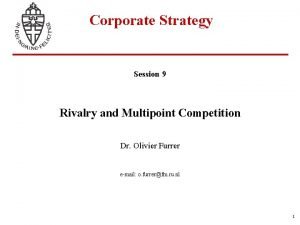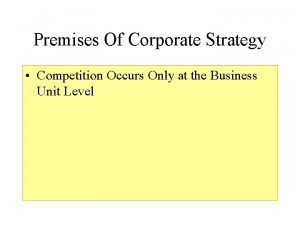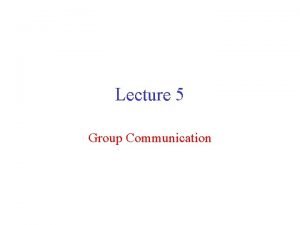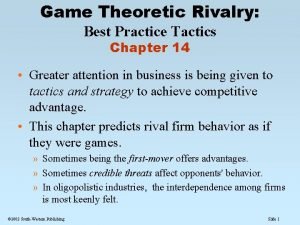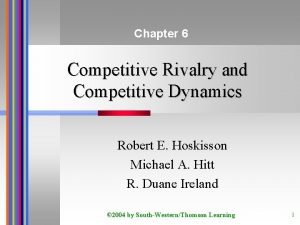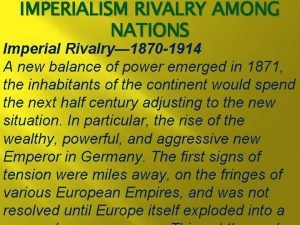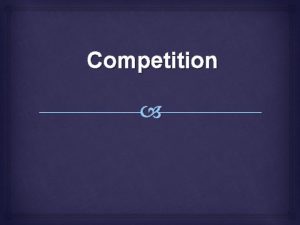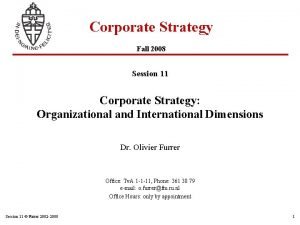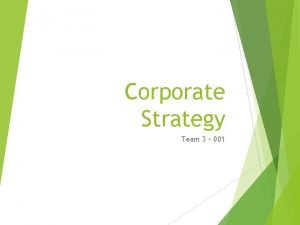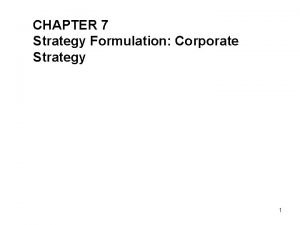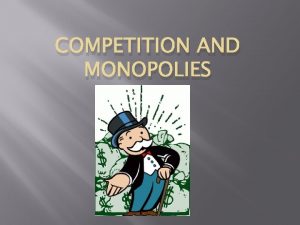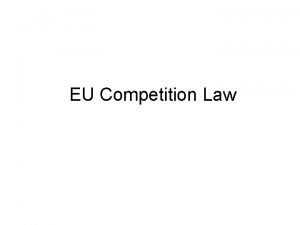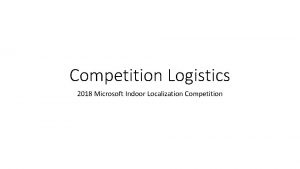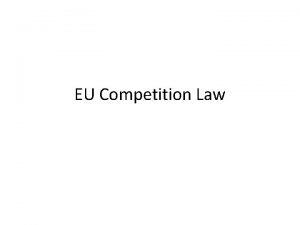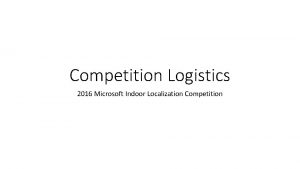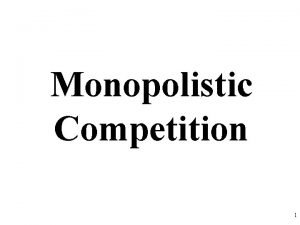Corporate Strategy Session 9 Rivalry and Multipoint Competition






























- Slides: 30

Corporate Strategy Session 9 Rivalry and Multipoint Competition Dr. Olivier Furrer e-mail: o. furrer@fm. ru. nl 1

Example In July 1969, Michelin announced plans to establish a plant in Canada which would give a foothold in the North American market, attacking market leader Goodyear. As a countermove, Goodyear entered the European market. Michelin continued to increase its market share in North America and attacked Goodyear in Brazil. (Karnani and Wernerfelt, 1985) 2

Example: Microsoft’s Xbox In the late 1990 s, Microsoft recognized that Sony could emerge as an important rival. Although Sony functioned in a different industry (i. e. , consumer electronics rather than software), Microsoft noted that the Sony Play. Station was, in essence, nothing more than a specialized computer and, even worse, one that did not use a Microsoft operating system. Microsoft thus worried that Sony might use the Play. Station II, which came equipped with Web browsing potential, as a “Trojan horse” that would gain control of consumers’ Web browsing and computing habits from their living rooms, ultimately taking those customers away from PCs with Microsoft operating systems. The desire to keep Sony’s ambitions in check was a significant part of the rationale for Microsoft’s diversification into the video game industry, with the launch of its Xbox. 3

Example: Disney and AOL–Time Warner Multipoint competition between The Walt Disney Company and AOL–Time Warner in the early 1990 s. Disney operates in theme park, movie and television production, and television broadcasting industries; AOL–Time Warner operates in theme park and movie and television production industries, while also operating a significant magazine business (publishing Time, People, Sports Illustrated, and others). Disney spends millions of dollars to advertise its theme parks in AOL–Time Warner magazines. Despite this substantial revenue, AOL–Time Warner initiated an aggressive advertising campaign, aimed at wooing customers away from Disney theme parks to its own. Disney retaliated by canceling all of its advertising in AOL– Time Warner magazines. AOL–Time Warner responded by canceling a corporate meeting that was to be held at Disney World. Disney in turn responded to AOL– Time Warner’s meeting cancellation by refusing to broadcast AOL–Time Warner theme park advertisements on its Los Angeles television station. 4

Definitions Competitive Dynamics Results from a series of competitive actions and competitive responses among firms competing within a particular industry Competitive Rivalry Exists when two or more firms jockey with one another in the pursuit of better market position 5

Definitions (cont’d) Multipoint Competition A situation where firms compete against each other simultaneously in several markets 6

Focus of this Session • The process by which multimarket (or multibusiness) affects interfirm rivalry • The factors that moderate the impact of multimarket (multipoint) competition on interfirm rivalry • The implications of multimarket (multipoint) competition for corporate- and business-level strategy 7

Multipoint Competition Firm A I II IV III IV Businesses I II Firm B 8

Factors Leading to More Complex Rivalry Declining emphasis on single, domestic markets and increasing emphasis on global and multiple markets Advances in communication technology make coordination easier across multiple markets Advances in technology and innovation have increased competitiveness of small and medium sized firms National barriers are falling due to the number and scope of trade agreements (WTO, NAFTA, EU) 9

The Rivalry Matrix Few Many Predictable Game Theory Warfare Models, Multipoint Competition Uncertain Nature of the Environment Decision Variables Scenarios, Simulation, and Systems Dynamics Frameworks Source. : Furrer, Olivier and Howard Thomas (2000), “The Rivalry Matrix: Understanding Rivalry and Competitive Dynamics, ” European Management Journal, 18 (6), 619– 637. 10

Model of Interfirm Rivalry: Likelihood of Attack and Response Drivers of Competitive Behavior Awareness Motivation Capability Competitor Analysis Market Commonality Interfirm Rivalry: Attack & Response Likelihood of Attack First Mover Incentives Likelihood of Response Type of Competitive Action Actor’s Reputation Dependence on the Market Resource Availability Ability for Action and Response Relative Size Speed Innovation Quality Resource Similarity Feedback Session 7 © Furrer 2002 -2012 Source: Chen, 1996 Outcomes Competitive Market Types Slow, Standard or Fast Cycle Competitive Outcomes Sustained Competitive Advantage Temporary Advantage Evolutionary Outcomes Entrepreneurial Growth-Oriented or Market-Power Actions 11

Multimarket Competition and Interfirm Rivalry: The Mutual Forbearance Hypothesis • Mutual forbearance is tacit collusion as a consequence of firms competing in many markets and the resulting increase in their interdependence. • Tacit collusion, as opposed to direct collusion, which is illegal, is a situation in which two firms understand each other’s motives and strategies and implicitly coordinate to avoid competing intensely. • Extent theory suggests that two different processes may be responsible for mutual forbearance as a result of higher degree of multimarket contact: familiarity (Baum and Korn, 1999) and deterrence (Bernstein and Whinston, 1990; Edwards, 1955; Porter, 1980). 12

Multimarket contact Between focal firm and rivals Larger number of interactions with rivals Better understanding of interdependence and overlapping market fortunes with rivals Ability to hurt Larger revenue exposure to rivals’ actions Greater attention to rivals in market scanning and competitor information acquisition Increased familiarity Opportunity to hurt Rivals’ opportunity to retaliate in multiple markets Lower expected payoff from rivalry Increased deterrence MUTUAL FORBEARANCE Lower intensity of competition Source: Jayachandran et al. , 1999 13

Model of Interfirm Rivalry: Likelihood of Attack and Response Drivers of Competitive Behavior Awareness Motivation Capability Competitor Analysis Market Commonality Interfirm Rivalry: Attack & Response Likelihood of Attack First Mover Incentives Likelihood of Response Type of Competitive Action Actor’s Reputation Dependence on the Market Resource Availability Ability for Action and Response Relative Size Speed Innovation Quality Resource Similarity Feedback Session 7 © Furrer 2002 -2012 Source: Chen, 1996 Outcomes Competitive Market Types Slow, Standard or Fast Cycle Competitive Outcomes Sustained Competitive Advantage Temporary Advantage Evolutionary Outcomes Entrepreneurial Growth-Oriented or Market-Power Actions 14

Model of Interfirm Rivalry: Likelihood of Attack and Response Drivers of Competitive Behavior Awareness Motivation Capability Do managers understand the key characteristics of competitors? Does the firm have appropriate incentives to attack or respond? Does the firm have the necessary resources to attack or respond? 15

Model of Interfirm Rivalry: Likelihood of Attack and Response Competitor Analysis Market Commonality Do firms compete with each other in multiple markets? Multipoint competition tends to reduce competitive interactions, but increases the likelihood of response where interaction occurs For example, airlines price flights similarly, but respond quickly when competitors introduce promotional prices 16

Model of Interfirm Rivalry: Likelihood of Attack and Response Competitor Analysis Resource Similarity Do competitors possess similar types or amounts of resources? Firms are less inclined to attack a firm that is likely to retaliate Firms with similar resources are more likely to be aware of each other’s competitive moves Firms with dissimilar resources are more likely to attack 17

Market Commonality and Resource Similarity Source: Chen, 1996 18

Intensity of competition Multimarket Contact and Intensity of Competition Low contact Medium contact High contact Degree of multimarket contact 19

Multimarket Contact and Intensity of Competition: A Contingency Model Organizational structure of competing firms Seller concentration Opportunities for scope economies Degree of multimarket contact Intensity of competition CEO’s tenure Spheres of influence Resource similarity Source: Furrer, 2010; Jayachandran et al. , 1999 20

Model of Interfirm Rivalry: Likelihood of Attack and Response Interfirm Rivalry: Attack & Response Likelihood of Attack First Mover Incentives Firm Mover advantage can be substantial Likelihood of Response Type of Competitive Action Actor’s Reputation Dependence on the Market Resource Availability 21

First Mover Firms that take an initial competitive action Generally possess the resources and capabilities that enable them to be pioneers in new products, new markets or new technologies Can earn above-average profits until competitors respond Gain customer loyalty, helping to create a barrier to entry by competitors Advantage depends upon difficulty of imitation Source: Lieberman and Montgomery, 1988 22

Second Mover Firms that respond to a First Mover’s actions Second Movers frequently imitate First Movers Speed of response often dictates success Should evaluate customers’ response before moving “Fast” Second Movers can capture some of initial customers and develop some brand loyalty Avoid some of the risks associated with First Move Must possess necessary capabilities to imitate Source: Lieberman and Montgomery, 1988 23

Model of Interfirm Rivalry: Likelihood of Attack and Response Interfirm Rivalry: Attack & Response Likelihood of Attack First Mover Incentives Likelihood of Response Type of Competitive Action Actor’s Reputation Dependence on the Market Resource Availability Whether a competitor is likely to respond depends on several key factors 24

Types of Competitive Actions Strategic Actions Significant commitments of specific & distinctive organizational resources Difficult to implement Difficult to reverse Example Tactical Actions Major Acquisition Undertaken to “fine tune” strategy Relatively easy to implement Relatively easy to reverse Example Price cut 25

Source: Karnani and Wernerfelt, 1985 26

Source. : Smith and Wilson, 1995 27

Gauging the Likelihood of Response Type of Competitive Action: Tactical or Strategic Easier to respond to Require fewer resources to mount a response Actor’s Reputation Market leaders are more likely to be copied “Risk taking” firms are less likely to be copied “Price Predators” are less likely to be copied 28

Gauging the Likelihood of Response Market Dependence Firms that are more dependent on a single industry are more likely to respond than are multimarket firms Industry dependent firms will likely respond to either strategic or tactical actions Competitor Resources Smaller firms are more likely to respond to tactical actions Limited resources may lead to alternatives such as Strategic Alliances 29

Model of Interfirm Rivalry: Likelihood of Attack and Response Ability for Action and Response Relative Size Speed Innovation Quality Firm size can have opposing effects on competitive dynamics Large firms may exert market power over rivals and erect barriers to entry against smaller competitors However, smaller competitors may be more nimble and innovative 30
 Stability strategy
Stability strategy Multipoint competition
Multipoint competition Corporate strategy
Corporate strategy Corporate strategy vs business strategy
Corporate strategy vs business strategy Strategic management chapter 7
Strategic management chapter 7 Lump sum subsidy
Lump sum subsidy Perfect competition vs monopolistic competition
Perfect competition vs monopolistic competition Market structures venn diagram
Market structures venn diagram Perfect competition vs monopolistic competition
Perfect competition vs monopolistic competition Disadvantages of cup and bob viscometer
Disadvantages of cup and bob viscometer Objectives of corporate finance
Objectives of corporate finance Market commonality and resource similarity examples
Market commonality and resource similarity examples Rivalry between the french and the british
Rivalry between the french and the british Childhood rivalry in bali and new guinea
Childhood rivalry in bali and new guinea Multipoint dashboard
Multipoint dashboard Multichannel multipoint distribution service
Multichannel multipoint distribution service Point to multipoint communication
Point to multipoint communication Dynamic multipoint vpn
Dynamic multipoint vpn Multipoint meter switchboard
Multipoint meter switchboard H323 open source
H323 open source English french rivalry
English french rivalry Advantages and disadvantages of bioleaching and phytomining
Advantages and disadvantages of bioleaching and phytomining Rivalry chapter 14
Rivalry chapter 14 Modern theory of trade
Modern theory of trade Rivalry 1 chap 6
Rivalry 1 chap 6 Non-rivalry
Non-rivalry Rivalry in north america lesson 4
Rivalry in north america lesson 4 Rivalry chapter 6
Rivalry chapter 6 Rivalry chapter 5
Rivalry chapter 5 Rivalry chapter 17
Rivalry chapter 17 Rivalry scan
Rivalry scan

